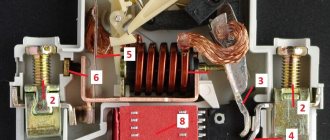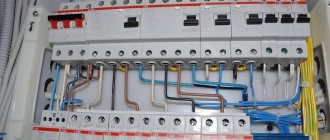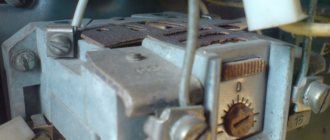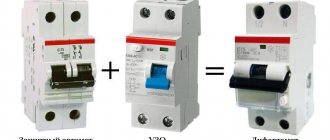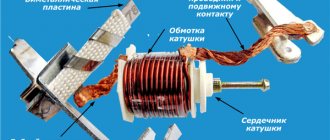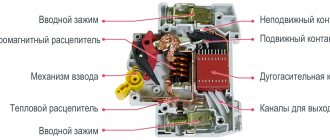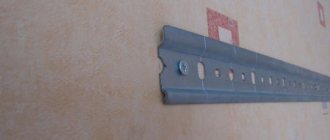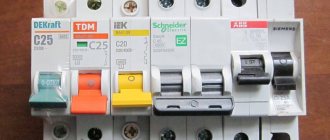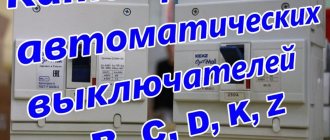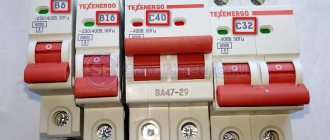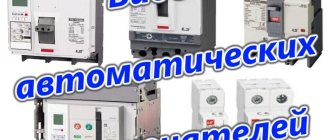A comb (bus) for circuit breakers is a device for assembling and installing distribution boards. It consists of a solid copper plate, which is placed in a plastic insulator.
According to the type of connected devices, combs are divided into:
- single-pole;
- bipolar;
- three-pole;
- four-pole.
The number of poles is equal to the number of plates that are in the comb bus.
The type of connecting busbars is selected depending on the task at hand. The most rarely used are three-pole combs. To connect single-phase machines, single-pole ones are most often used, and for three-phase machines, four-pole ones are used.
The size range of comb pitches ranges from 18 mm to 27 mm. Possible number of modules (teeth): twelve, twenty-four, thirty-six, forty-eight, sixty.
Design
The combs (tires) consist of a plate placed in a plastic housing and pins, which are called teeth. The body is solid. The pins are bare, that is, they do not have any protective plastic shell, since they are inserted into contacts for the purpose of connecting a protective modular structure.
They can be L-shaped or V-shaped, but the first option is most common.
A standard single-pole comb is presented in the form of a rectangular reddish-yellow plate located in a housing made of refractory plastic.
In the two-pole type there are two bars. The distance between the pins is greater than that of a single-pole one. The reason is that this type of comb has several power cables for connection: phase-zero (L+N) or phase-phase (L1+ L2). The pins in this case go through one another.
How to connect a machine in a panel without errors
- Everyone is well aware that before connecting to a contact, the insulating layer must be removed from the wire. After this, the bare end of the conductor is immersed in the terminal, and it is tightened until it is completely fixed. Everything is easy and simple, but nevertheless, mistakes are made here all the time.
- If in your house with new wiring the electricity suddenly goes out or a completely new circuit breaker burns out, then the reason may be a banal clamping of the insulation layer by the terminal. This situation leads to significant heating of the contact, and there is a risk of melting the insulation of the machine itself, which can lead to a fire. Why is this happening? The fact is that the insulation will prevent normal contact between metals, the resistance increases, which causes heating. If there is a loose touch, sparking constantly occurs, and large loads on the circuit can lead to an arc discharge.
- The second mistake is when craftsmen use wires of different sections to connect to one terminal.
Types of bends
There are two types of outlet of connecting combs:
- Pin type (marked “pin”) - suitable for almost all types of safety units, regardless of the manufacturer.
- Fork ones (marked “fork”) are extremely rarely used, since connection requires a special clamp, which is not present on all devices. Used by branded companies.
Characteristics
Now there are very clear requirements for the selection of zero tires
The most important rule is not to exceed the wire cross-section of a similar indicator in the GZSh. So that you understand, it is possible to enter from one to four dozen wires into the box
For example, for the 3 by 40 option, a wire is provided, the cross-section of which reaches 3 millimeters with a maximum allowable connection of four dozen.
As for the technical specifications, we have provided some of the parameters in the table below. Each manufacturer has its own design features and characteristics of zero tires. For example, we took IEK products:
Algorithm for connecting automatic tires
To connect automatic tires you need:
- take a comb and remove the reddish-yellow tire from it;
- if the connection requires fewer circuit breakers than there are taps on the comb mounting rail, then you should cut off the required number of teeth (three, five or seven teeth - depending on your case). This operation can be performed with any tool suitable for the situation, for example, a hacksaw. It is better to cut the parts separately: the insulator separately, the tires separately;
- then, you should cut the plastic block body according to the length of the copper plate, preferably a little more than necessary, so that parts do not stick out from the edges of the comb. This will also help prevent short circuits. Specialized plugs should be placed on the cut sides of the insulator, which, as a rule, are sold complete with the connecting busbar. But if there are none, then you can use electrical tape;
- the bus should be inserted on top of the connected devices (each tap should be connected to the corresponding contact socket). Next, you should screw the comb under the entire row of required machines and connect the power. It is at this point that the wire is connected together with the bus in the machine.
Design features
Figure 2 shows a disassembled single-phase legrand comb bus for 12 modules. As you can see, the design of this device is quite simple; it includes a copper bus “a” and its insulator “b”. Everything is simple and convenient.
An example of using such a comb is shown in Figure 3.
- A - two-pole circuit breakers are connected using two single-pole connectors (zero bus and phase);
- B – connection of devices of the same type when a three-phase electrical power supply is used. Single-pole and three-pole contact jumper are used;
- C – use of a four-pole jumper (common zero and three phases) for automatic circuit breakers or three-phase RCDs.
Note that two-pole combs are also produced; the principle of their connection is the same as in option “A” in Figure 4.
Features you need to pay attention to.
The shape of the taps can be of the pin type (this design is shown in Figure 2) and “fork” (see Figure 5). The first option is more common because it can be used with various types of devices.
As for the “fork” taps, their connection to the module is possible if it has an appropriate clamp, for example, like the two-terminal switch of the ABB S200 series, shown in Figure 6.
It is necessary to pay attention to one more nuance related to the design features. There are many examples where problems arose when connecting the connecting bus. There is only one explanation for this - an incorrectly selected comb, especially branded products, for example, IEK, Hager, ABB, etc., are critical to this.
Therefore, to avoid installation problems, purchase combs and protective devices from the same manufacturer. But even in this case, as we saw with the example of ABB products, consultation with a specialist will not be superfluous.
Expert opinion
It-Technology, Electrical power and electronics specialist
Ask questions to the “Specialist for modernization of energy generation systems”
Methods for connecting machines in a distribution panel Soldering wires to the terminal of a machine - ERROR error Separately, I would like to dwell on this method of terminating wires in a panel as soldering. Ask, I'm in touch!
Installation
Installation of a conventional comb bus takes place within the boundaries of the input or distribution panels. Usually this process does not raise any questions.
Features of connecting the bus under the comb:
- during installation, the conductive portion of the comb comes between the lower pressure plate and the comb itself, which is why the plastic insulating stage on it is directed towards the screw-shaped fastening;
- if this requirement is violated, it will not be possible to obtain an aesthetic connection that will not bend the plate;
- when installing a three-phase type comb, it is necessary to monitor the accuracy of the position of the insulators in order to eliminate the possibility of an interphase short circuit;
- When installing connecting busbars for automatic machines instead of typical cable jumpers, it is important to adhere to the generally accepted markings, which are located on the housings of the mounted products, and also meet the conditions of the existing standards.
The best manufacturers
The market now offers a huge number of connecting busbars produced by various manufacturers, from global corporations to local companies. However, there are manufacturers who have proven themselves to be the best, whose products can be purchased without fear for their quality, performance and reliability.
At the moment, one of the leaders and the most famous manufacturer of power equipment, including connecting busbars, on the world market is the Swiss company ABB. The company's products are reliable, safe and wear-resistant.
The products of the French brand Legrand, specializing in the production of electrical products, are also popular. The products produced by the company comply with the latest European quality standards and can be used with equal success both in simple residential panels and in large production facilities.
In the domestic market, one of the leading manufacturers and suppliers of electrical equipment at the moment is the IEK company, which achieved its success thanks to the extreme availability of products for consumers and twice became the winner of the “Brand No. 1 in Russia” award.
The Kursk Electrical Apparatus Plant (KEAZ), which existed back in the USSR, successfully competes with the IEK brand. The products manufactured by the plant are distinguished by their reliability, durability and relatively affordable price, and the selection line is currently one of the largest in the domestic market.
I would also like to mention the Chinese company EKF electrotechnica, which is quite well known in Russia. The price and quality of the products it produces are comparable to the parameters of IEK brand products, however, the five-year warranty period forces many to choose this company.
Advantages and disadvantages
The disadvantages of copper-based connecting combs include:
- the constant need to turn off the power when necessary to repair or service the device, which creates certain inconveniences;
- difficulties in implementing the modernization of the shield. If you need to install an auxiliary device, you will need to change the connecting comb or install an adapter jumper. But this may have a negative impact on the properties of the contacts;
- changing the first blown circuit breaker will require unfastening each contact on each device, but dismantling the bus may not work any other way;
- Due to the fact that different manufacturing companies in most cases can allow discrepancies in dimensions and instruction volumes, there is a need to install connecting busbars from only one manufacturing company together with the device that is planned to be connected. Choosing different companies may lead to the fact that the electrical connection will be impossible, because the pin may simply not reach the clamping contact;
- using homemade jumpers consisting of wire and electrical tape when connecting machines can be much cheaper than using a connecting bus. But this drawback applies to products from well-known brand manufacturers;
- using a connecting comb is pointless when connecting 1 or several machines. The reason for this is that it is designed for more than six modules.
One of the most popular combs on the Russian market are combs from ABB (abb or abb). This is a Swedish-Swiss company located in Zurich.
The advantages of copper-based connecting combs include:
- ease of use and high assembly speed;
- guarantees a high-quality and also safe galvanic connection, since the terminal can only clamp one contact (the exception is the first terminal, into which power is supplied from the line of the used pin bus, and the fork bus is free from this drawback).
- reduces the total number of contacts by 2 times, and due to this, the reliability of the resulting connections increases, eliminating the possibility of excessive heating of the contact points;
- An inherent advantage is the switching property; contact with a branch core is many times better than using a single-core cable as a jumper. Using a comb almost eliminates overheating of the contact pad;
- most often, the busbars of a connecting comb for six modules are designed for a load of 63 A. In order for the wire to withstand this load, it must have a cross-section of at least 16 square millimeters, and this significantly makes working with it more difficult;
- thanks to the comb in the shield, the number of wires is reduced, which affects the neatness of the wiring, as well as its indicativeness. This makes it easier to understand it if the need arises. The use of a comb allows you to independently carry out high-quality wiring.
Using a comb for automatic machines makes installation in the switchboard much easier and faster, and this fact is the main advantage.
Alignment methods
Comb
To correctly connect the machines, it is good to use a bus or comb, which is selected depending on the number of phases:
- for a single-phase circuit, a two-pole as well as a single-pole model is suitable;
- three-phase - four and three-pole.
Installation is easy. For the required number of machines, a specific comb model with the required number of poles is selected.
When choosing a comb with the maximum number of contacts, you should remove the excess using a hacksaw. To complete the installation, the tire is inserted into each clamp at the same time, and then the screws are tightened. The outputs are installed according to the diagrams.
Jumpers
Connecting machines using jumpers is used when there are a small number of switches and there is enough space in the panel for unhindered access to all contacts. This method can be used not only for a single-phase type of circuit, but also for a three-phase version.
For work carried out in the panel, it is worth preparing all jumpers of the required length, as well as the appropriate cross-section. For the so-called single-core conductors used, a cross-section is selected to combine the wires of the machines with a pre-calculated power. One of the suitable methods for creating jumpers is the continuous method.
At the end of such preparation, it is preferable to remove the existing insulation from the ends by about a centimeter, then expose the wire by removing the film with a knife.
Then you should install the ends into the entrance holes, while tightening the screws. Then the load sources are connected to the output, as in the photo, which clearly shows the connection of automatic switches.
Do not forget that it is important to not press the neutral and phase wires tightly because of their possibility of heating during operation of the electrical network, as well as the likelihood of unwanted alignment of the zero with the phase due to softening of the insulation under the influence of heating.
To combine switches with a cable, you can use a stranded wire with the required cross-section
However, in this case it is important to clean it a few centimeters.
A special tip corresponding in size to the cross-section of the wire used should be put on the end, crimped using pliers. You can combine switches in sequential order.
Following the instructions for combining switches located in the panel, but in the absence of the required tools, as well as tips, you can tin the uninsulated wire using a soldering iron.
In the absence of a special soldering iron, installation can be carried out using conductors without insulation. Such an installation is not practical and, under excessive loads, can cause overheating of the conductors in the overlap area and, naturally, a high degree of danger of unwanted fire. This type of association does not have an attractive appearance.
Remember that the correct connection of machines with each other using a stranded conductor should be carried out by adhering to a previously developed diagram. In this case, you can use machines from different manufacturers. Their diameters can be completely different, since installation with a flexible type wire makes it possible to do this.
When deciding which wire is preferable to connect the machines, check the correctness of this connection. As a rule, this is common for a three-phase circuit. Even a tiny mistake can cause a short circuit and, consequently, damage to the electrical device you are using.
Characteristics
How to connect ouzo and automatic machines correctly: diagrams, expert advice and simple step-by-step instructions
When choosing the necessary zero buses, it is worth presenting clear requirements for the design. The main thing is the cross-section of the wire. Guided by the clear rule “the cross-section of the wire does not exceed the cross-section of the main grounding bus,” you can provide high-quality power supply and save money on maintenance in the future.
The characteristics of the zero bus vary depending on the type of installation. There are two types of devices according to the distribution scheme that meets the requirements of the PUE:
In the first case, a grounded bus, which is a tightly grounded neutral, in which connection to the protective ground is provided exclusively at this point. Further, only two busbars are inserted into the shield along the insulated conductors. This scheme is considered the safest, since the neutral and grounding buses are separated directly at the entrance of the device into the room.
The second option presents an outdated but popular TN-C type circuit. In this case, the grounding is not represented by a separate conductor, but in the panel itself there is only a zero bus. Here, too, you cannot connect ground and zero. Therefore, here the concept of “earth” in its usual representation is not present.
PUE safety requirements
The power supply system is ideally compiled according to the circuits recommended by the electrical installation rules (PUE). A power cable is connected to a residential premises or to a separate facility, and its subsequent wiring inside the building is provided using a distribution panel.
For the convenience of such wiring, a zero bus is used. Simply put, such a device is a reinforced open-type conductor in the contact zone. Neutral conductors are connected to it using screw connectors.
A common bus design is a rectangular bar made of durable metal with characteristic conductivity: brass, copper alloys.
Installation Rules
Installation of the NS is possible both on a special rail and in an electrical panel. Installation options are available in both closed and open ways. The open method is perfect for a cabinet that will be closed to unauthorized persons. The closed version is used in situations where equipment is used that is connected to very important elements. An example is a power socket for various electrical tools.
The video below clearly shows how to install the NS on a DIN rail and how to fix it more reliably:
So we looked at the structure and purpose of the zero bus. We hope the information was useful and interesting for you!
Source samelectrik.ru
An electrical panel in a private house, country house, or apartment performs a dual function: it provides input and distribution of electricity and creates safe operating conditions. If you want to understand a difficult issue, you can assemble the electrical panel yourself. The input machine and the meter must be installed by representatives of the electricity supply organization, but then, after the meter, you can assemble the circuit yourself (although they do not like to lose money). True, before putting the house into operation, you will need to invite them so that they are present during the start-up, check everything and measure the ground loop. All of these are paid services, but they cost much less than a complete panel assembly. If you do everything correctly and according to the standards, it will turn out even better on your own: after all, you are doing it for yourself.
Marking for three-phase alternating current
The principle of operation of an RCD: how to correctly connect an RCD
“Hints”, which are expressed in the color and letter designation of tires and wires, will help you identify the elements of electrical installations. They are not chosen randomly. They are regulated by standards.
There are two ways to color code tires. The first implies that the marking of electrical busbars is applied at the manufacturing stage. The manufacturer uses insulation of different colors. The second is suitable in cases where the product has one color. In such situations, colored electrical tape is used to mark different phases.
In the case of three-phase current, the marking will look like this:
Phase “A” turns yellow.
Phase “B” is colored green.
Phase “C” is colored red.
Varieties of combs
There is no universal connecting bus suitable for any circuit breaker. The machines have different dimensions, number of pins and other characteristics. Therefore, combs come in a wide variety.
Based on the shape of the contacts, there are 2 types of comb busbars:
- Pin (toothed). Universal contact suitable for any machine.
- Forked. Used where the tire needs to be clamped under screws.
The combs differ in length, that is, in the number of machines that can be connected to them. If necessary, a tire that is too long can be shortened with a hacksaw. But it is preferable to use products for a standard number of machines:
- 12;
- 24;
- 36;
- 48.
There are also differences in the number of connected phases. From this point of view, connecting busbars are of the following types:
- Per 1 pole (1P). Used to connect single-phase group circuit breakers.
- 2 poles (2P). RCDs, automatic circuit breakers and any other devices that require a phase and zero connection.
- 3 poles (3P). Used to connect three-phase group circuit breakers.
- 4 poles (4P+N). Three-phase machines and devices that require a neutral wire to operate (three-phase RCDs).
Pin connection bus for three-phase network
Important! If you had to cut one large tire into several small ones, then you need to pay attention to the resulting cut. Individual conductors must not be bent or shorted together. After cutting, you need to remove copper dust from the comb
After cutting, you need to remove copper dust from the comb.
Purpose
The use of a zero bus makes it possible to solve several very important problems:
First of all, you can create several points at once to connect loads from the common input to a zero-type conductor. Conduct visible grounding using a device with a cover made of transparent material that covers the terminals. Significantly improve the effective use of automatic protective devices. Ensure continuity of the circuit in the area from grounding to a specific load. Fulfill an important condition, which involves separating the wires of the neutral (protective) and working types. About how to split a PEN conductor
We talked about it in a separate article.
